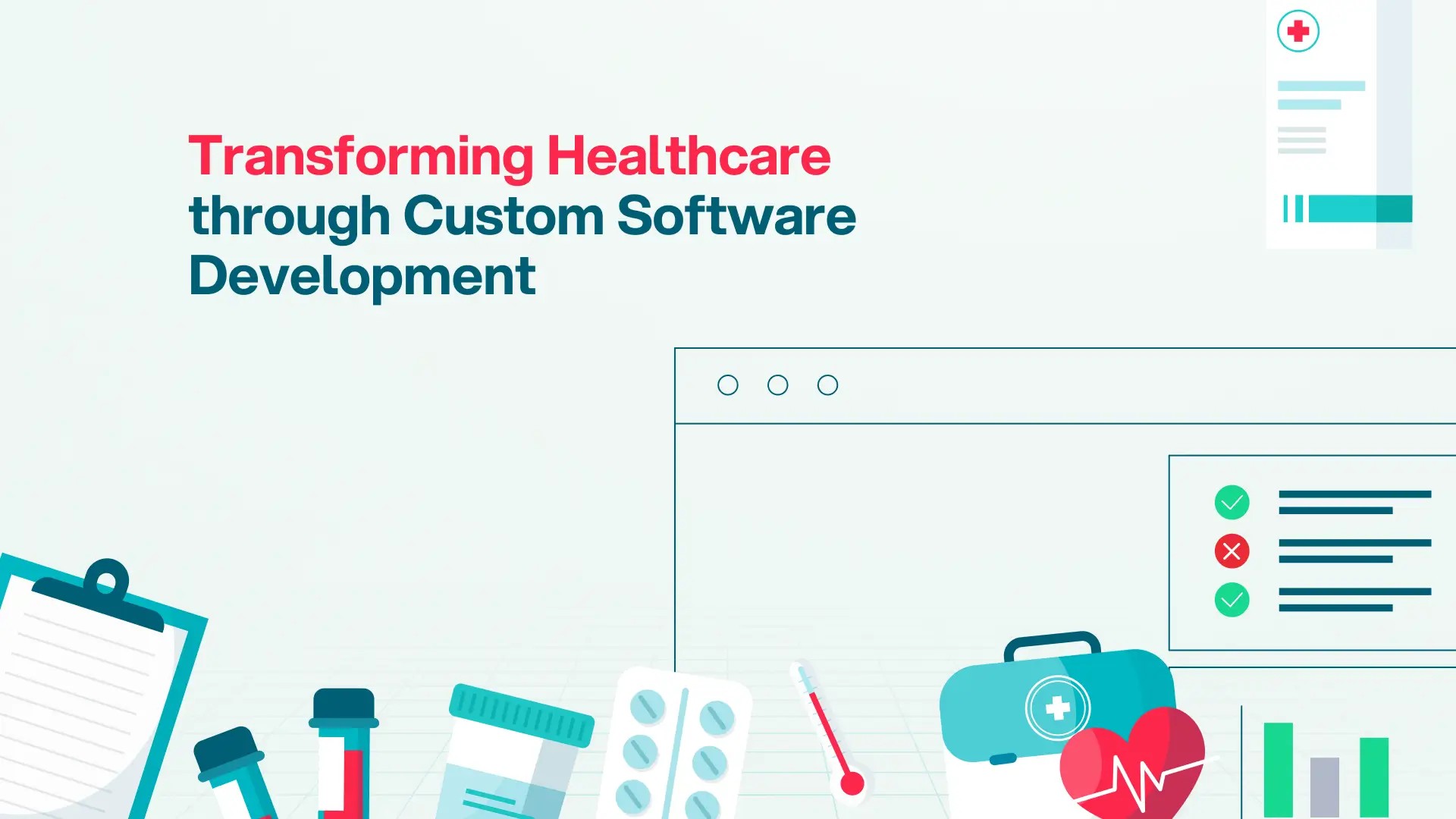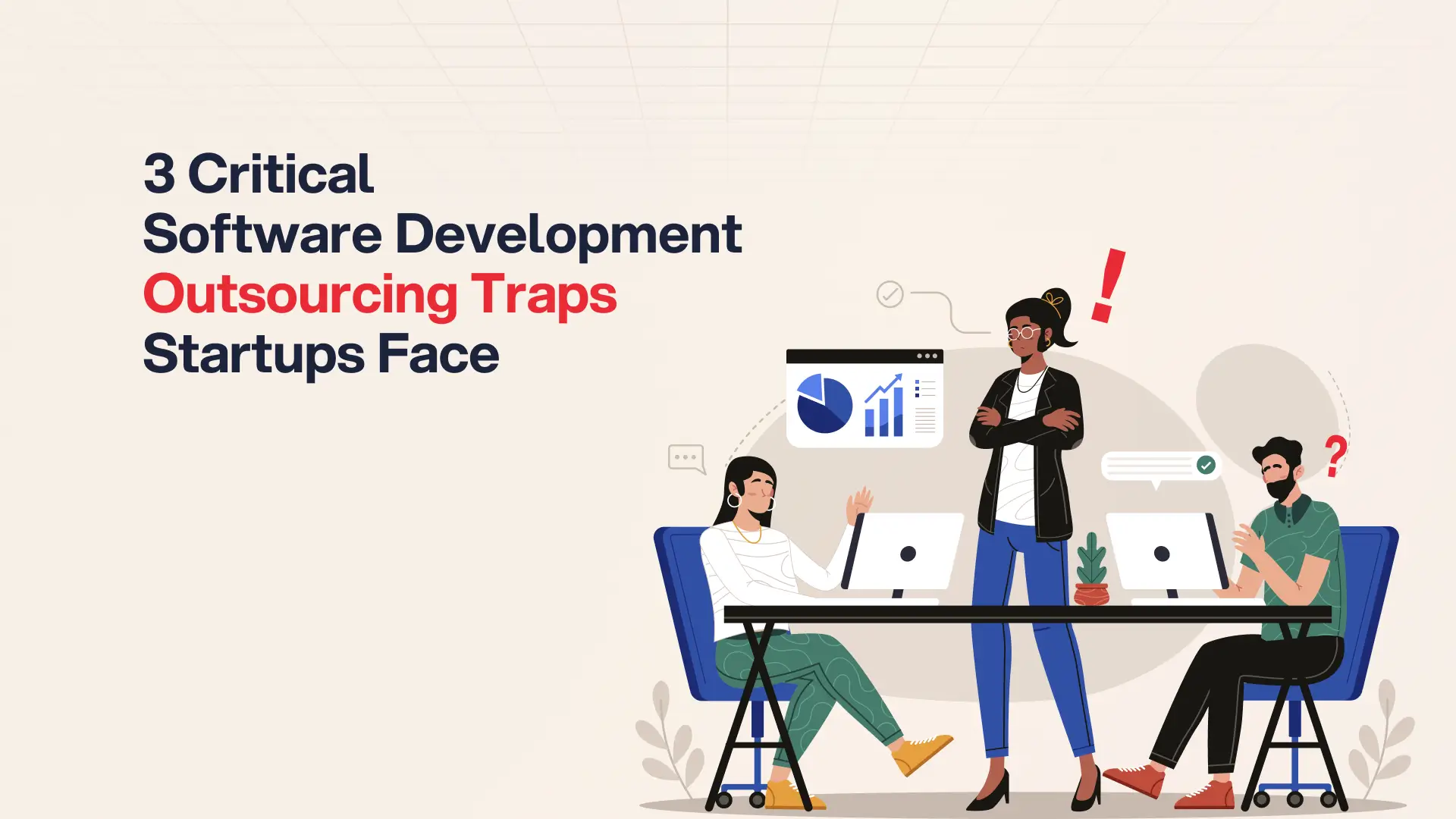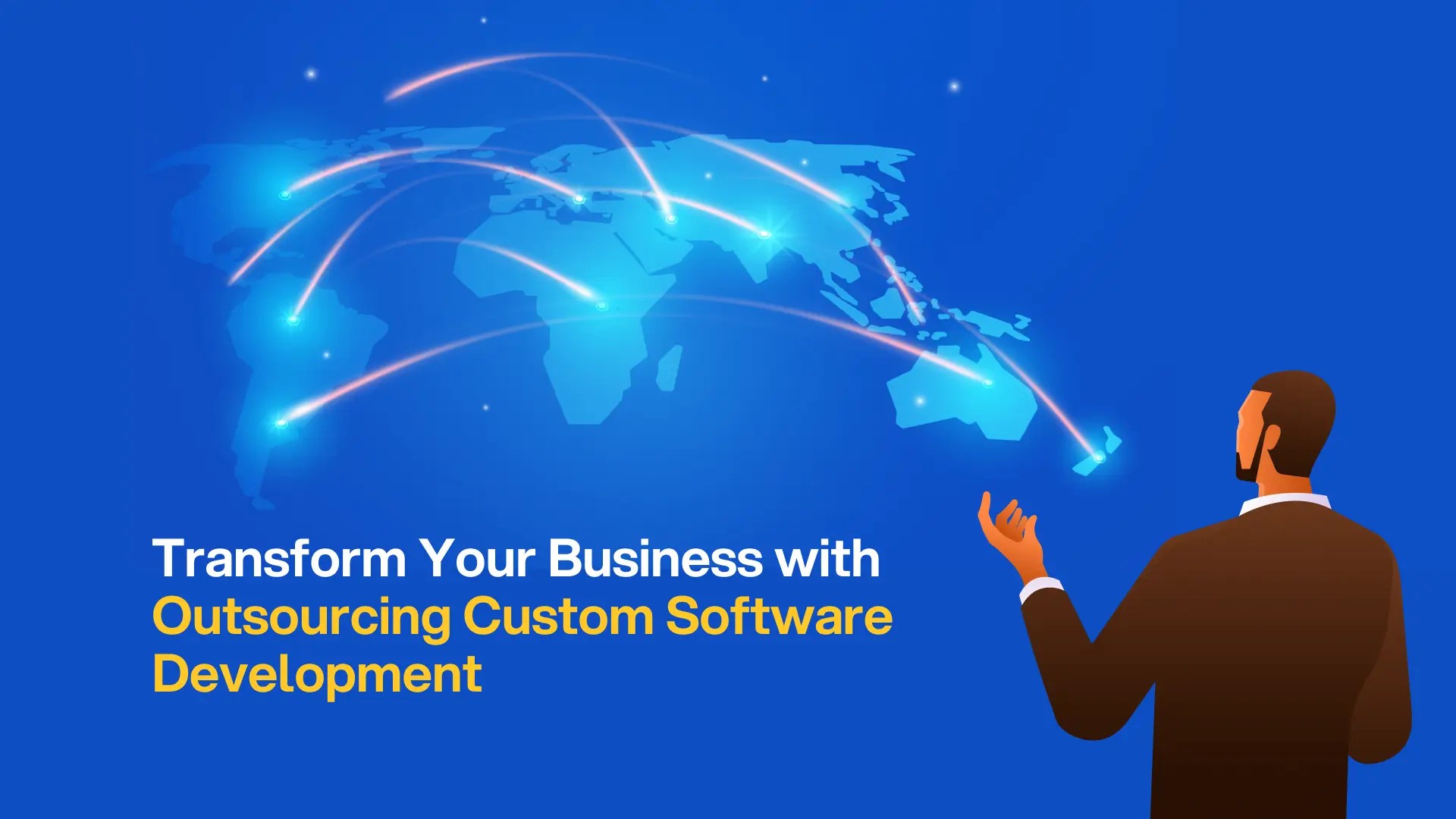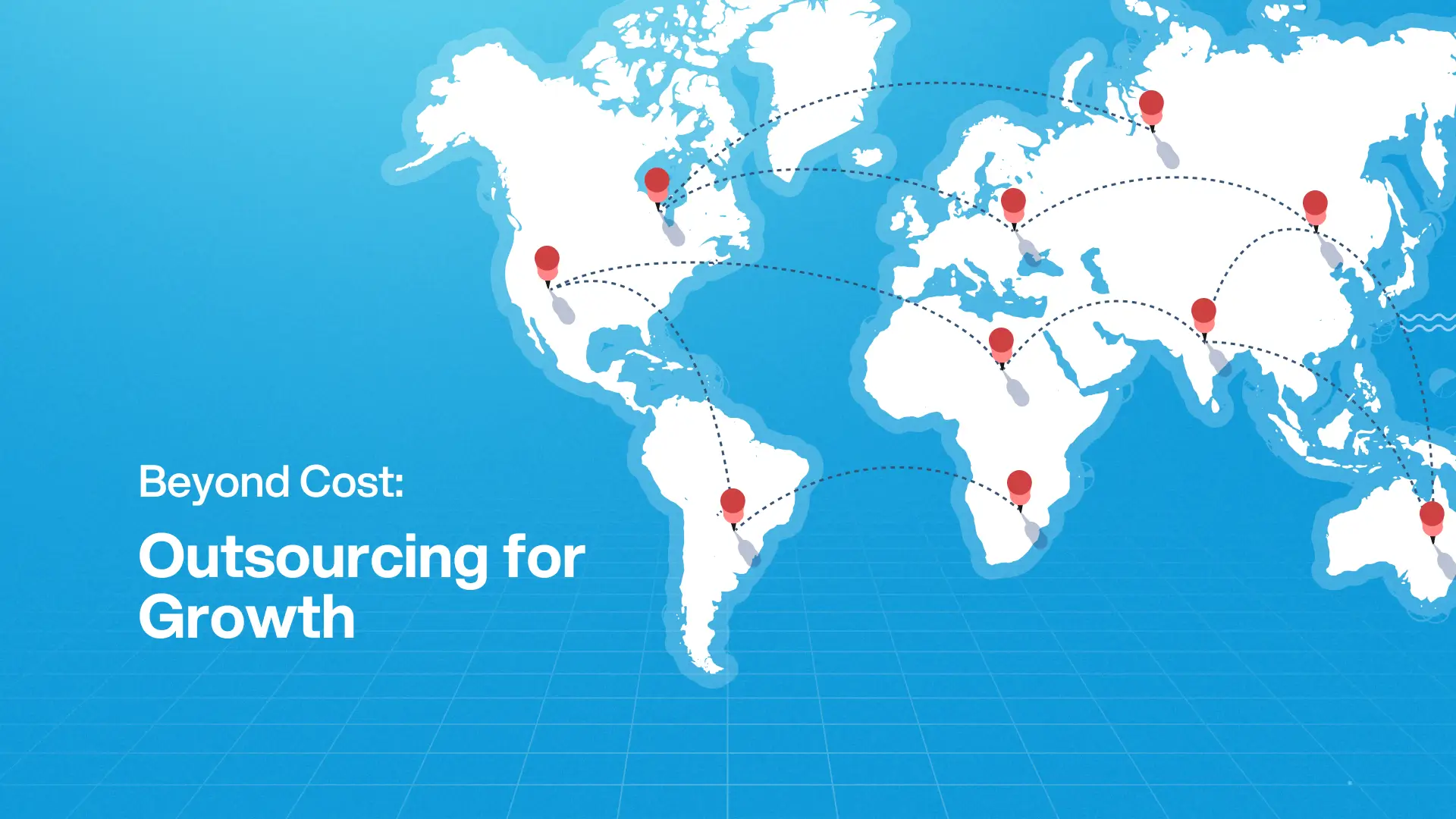Post Activity
 1250
1250
Table of Content
Share This Post
Table of Content
Today’s IT environment demands a strategic foundation that supports scalability, resilience, and innovation. Managed IT Services have evolved into a critical enabler of these goals. It helps businesses reallocate internal resources, strengthen cybersecurity protection, and accelerate digital transformation initiatives.
For technology leaders navigating complex systems, internal staff limitations, or aggressive growth targets, service providers represent a structured pathway to enhance IT performance while maintaining accountability for core operations.
What Are Managed Services?
Managed Services involve delegating specific technology functions to a third-party vendor, commonly referred to as a Managed Service Provider (MSP). These providers deliver a broad range of solutions under defined Service Level Agreements (SLAs), including cloud services, network monitoring, firewall management, backup services, and disaster recovery.
This model has replaced the older cost-plus pricing structure with a shift to value-based and outcome-based pricing, where pricing reflects delivered outcomes rather than resource utilization.
The Evolution of Managed IT Services
What began as outsourced support for technical issues has grown into a sophisticated services industry supporting strategic transformation. The introduction of cloud technology and the need for continuous compliance have elevated the role of Managed Service Providers from vendors to indispensable partners.
Types of Managed IT Services
Strategic decision-makers must understand the core categories that directly impact enterprise scalability, efficiency, and innovation. Below is a breakdown of key service areas that enable organizations to align IT operations with broader business goals.
Each service area below represents a high-leverage opportunity to reduce risk, increase agility, and redirect internal capacity toward strategic initiatives.
Thinking of Outsourcing?
Access a wide range of outsourcing companies and find your best fit.
Each of these categories provides standout advantages that go beyond day-to-day support. They are essential for companies pursuing digital transformation initiatives and modern customer experience strategies.
Selecting the right combination of services within your Co-Managed IT Services or fully managed engagement should align with your organization’s strategic goals, regulatory compliance requirements, and capacity for innovation.
Benefits of Managed Services
As companies grow, so do the demands on their IT infrastructure. By partnering with an MSP, your organization can redirect internal resources toward innovation while gaining operational agility and access to top-tier expertise.
Here are three key benefits driving business adoption of managed IT services:
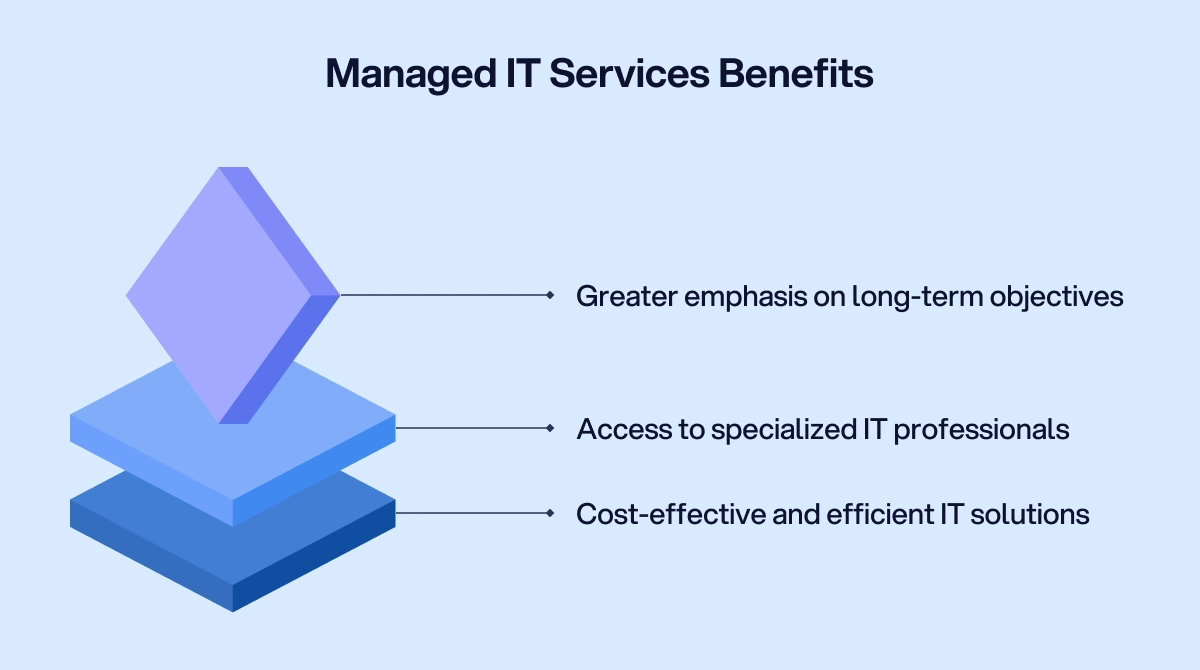
Greater emphasis on long-term objectives
With an MSP handling day-to-day IT operations, internal teams can prioritize strategic planning, product development, and digital transformation initiatives.
Access to specialized IT professionals
Managed services unlock a pool of expert talent across cybersecurity, cloud architecture, and infrastructure—without the burden of full-time hiring or upskilling.
Cost-effective and efficient IT solutions
From predictable pricing models to faster incident resolution, MSPs help reduce downtime and optimize resource usage, improving ROI across your IT stack.
Cost-Effective Solutions and Operational Efficiency
Shifting from in-house to remote management can yield substantial cost savings and reduce dependency on expensive technologies.
Access to Expertise and Specialized Staff
MSPs offer access to expert solutions, including specialized expertise in AI, cloud, and regulatory compliance. Such expertise requires extensive staff training and high retention budgets.
Greater Focus on Strategic Goals
By outsourcing routine infrastructure management and patch management, leaders can reallocate capacity toward strategic projects and core business objectives.
Healthcare Case: Altimetrik developed a HIPAA-compliant, cloud-based SaaS solution that integrated with various EHR/EMR systems. This platform enabled a unified view of patient data across systems and achieved a 20% reduction in hospital readmissions through proactive care and continuous engagement.
Limitations and Considerations
While the benefits are significant, decision-makers must consider:
- Degree of vendor lock and proprietary systems
- Lack of industry-specific knowledge in generalized offerings
- Erosion of tribal knowledge and house expertise
These risks can be mitigated by choosing forward-thinking partners offering transparency, a consultative approach, and regular documentation of internal processes.
Ready to Build Your Team?
Let’s create together, innovate together, and achieve excellence together. Your vision, our team – the perfect match awaits.
How to Assess Your IT Landscape
A structured assessment of your IT environment is essential for aligning operations with business priorities. Go beyond surface-level metrics and evaluate:
Strain on internal teams managing day-to-day support
- Presence of knowledge gaps, recurring technical issues, or lack of specialized staff
- Gaps in scalable solutions and comprehensive IT solutions are needed for growth
- Capacity to execute on strategic objectives and core business initiatives
If your IT function is reactive, overextended, or misaligned with long-term goals, it signals the need for a crucial partnership. In such cases, service providers are not merely cost-effective; they are a strategic enabler of resilience, agility, and competitive advantage.
Choosing the Right Service Providers
Look for MSPs with a proven track record in your domain. They should also offer:
- Strong network support services.
- Partnerships with platforms like Azure Service and IBM Application Management.
- Innovative pricing models, such as Tiered Pricing.
- Clear differentiation between one-off projects and ongoing support.
Top-tier MSPs like KPMG Managed Services combine industry expertise with comprehensive services, enabling client organizations to handle future challenges and reduce reliance on reactive support models.
Trends and Innovations in Managed IT Services
As the services landscape evolves, organizations are rethinking how they deploy IT capabilities to support resilience, speed, and innovation. These emerging trends are reshaping the role of Managed Service Providers from tactical vendors to indispensable partners in strategic execution.
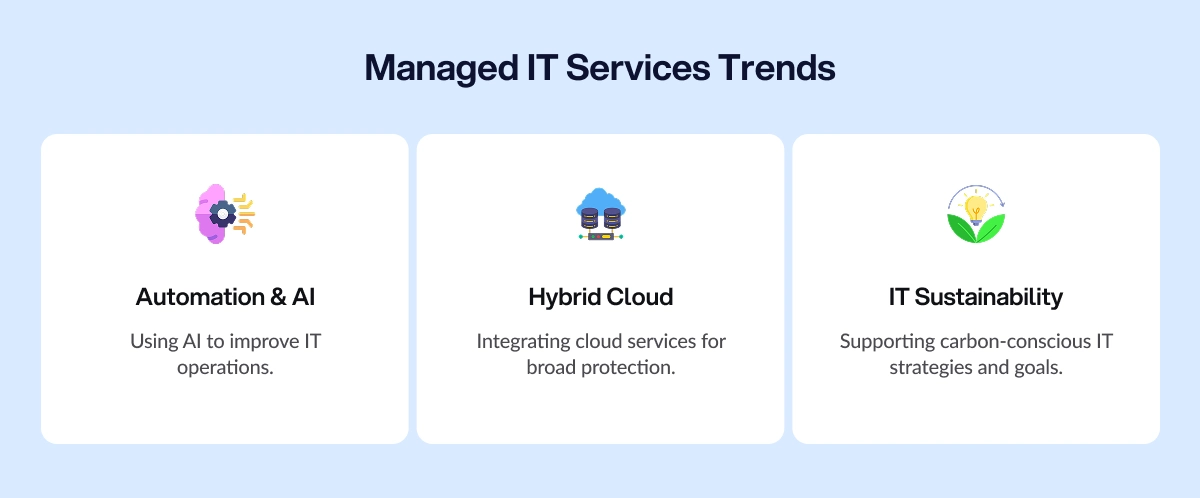
Automation and Artificial Intelligence
The integration of artificial intelligence and automation into IT operations is a dominant approach to delivering operational excellence. 68% of organizations are leveraging AI tools for anomaly detection, root cause analysis, and real-time threat detection, ensuring a proactive approach to IT management (LogicMonitor). Platforms powered by AI now:
- handle the monitoring of servers,
- perform issue detection,
- automate patch management,
- and improve service delivery with predictive analytics.
This shift enables proactive monitoring, reduces human error, and allows for real-time decision-making.
Hybrid Cloud Infrastructure and Scalable Solutions
The demand for hybrid cloud infrastructure is increasing as organizations adopt cloud services spanning AWS, Azure, GCP, and private environments. MSPs are stepping in to deliver broad-spectrum integration, policy orchestration, and comprehensive protection across platforms.
This flexibility is essential for businesses with integration challenges, strict regulatory compliance, and the need to optimize workloads for cost efficiency and performance.
Sustainability in IT Operations
Sustainability is emerging as a competitive differentiator. Services companies are now expected to support carbon-conscious IT strategies by optimizing field services, reducing energy consumption in data centers, and adopting greener device pricing models.
MSPs are integrating Environmental, Social, and Governance (ESG) principles into their service models, helping organizations meet sustainability targets without compromising levels of service.
Final Thoughts
Managed IT Services are reshaping how organizations align IT with business goals. From reducing upfront costs to increasing operational excellence, the right MSP can become a crucial partnership for business challenges ahead.
This is not about finding a cure-all solution. It is about selecting a proactive partner that delivers high-quality service, supports continuous monitoring, and helps you meet long-term success by focusing on core operations and strategic initiatives. For companies seeking more than a vendor, for those aiming to fuel business growth, Managed Service Providers are no longer optional. They are the key to success.
Find Your Perfect Software Outsourcing Partner
Unlock a world of trusted software outsourcing companies and elevate your business operations seamlessly.

